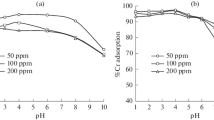Abstract
The removal and recovery of nickel(II) from wastewater of an electroplating factory was investigated using the waste Escherichia coli biomass as the biosorbent. The results were compared with those from using Amberlite IRN-150 as a commercial sorbent resin. The resin showed better performance with a q max value of 30.48 mg/g compared to 26.45 mg/g for the biomass, as predicted by the Langmuir isotherm model. Kinetic experiments revealed that the biosorption equilibrium was attained within 15 min. In the recycling of the sorbents, the desorption of nickel(II) from Amberlite was only 50%, which is too low for the adsorption performance of the resin to be maintained at an economic level in subsequent cycles. In contrast, the biomass exhibited reasonable adsorption-desorption performance over three repeated cycles. The capability for repeated use of the sorbent over several cycles and for recovery of the metal ions is the main advantage of the waste biomass.
Similar content being viewed by others
References
B. Volesky and Z. R. Holan, Biotechnol. Prog., 11, 235 (1995).
G. Selvakumari, M. Murugesan, S. Pattabi and M. Sathishkumar, Bull. Environ. Contam. Toxicol., 69, 195 (2002).
A. L. Mukherjee, Environmental Pollution and Health Hazardscauses and control, Golgotia publications, New Delhi (1986).
S. P. Parker, Encyclopedia of Environmental Science, 2nd Ed. McGraw Hill, New York (1980).
A. Selatnia, A. Madani, M. Z. Bakhti, L. Kertous, Y. Mansouri and R. Yous, Miner. Eng., 17, 903 (2004).
A. Papadopoulos, D. Fatta, K. Parperis, A. Mentzis, K. J. Haralambous and M. Loizidou, Sep. Puri. Technol., 39, 181 (2004).
N. Bukhari, C. M. Ashraf and M. Mazhar, J. Membr. Sci., 283, 182 (2006).
A. Agrawal, M. K. Manoj, S. Kumari, D. Bagchi, V. Kumar and B. D. Pandey, Miner. Eng., 21, 1126 (2008).
M. Tanaka, Y. Huang, T. Yahagi, M. K. Hossain, Y. Sato and H. Narita, Sep. Purif. Technol., 62, 97 (2008).
P. R. Puranik and K. M. Paknikar, J. Biotechnol., 55, 113 (1997).
I. Langmuir, J. American Chem. Soc., 40, 1361 (1918).
H. Freundlich, J. Phys. Chem., 57, 385 (1906).
S. Lagergren and B. K. Svenska, Veterskapsakad Handlingar., 24, 1 (1898).
Y. S. Ho and G. McKay, Process Biochem., 34, 451 (1999).
R. Nadeem, T. M. Ansari and A. M. Khalid, J. Hazard. Mater., 156, 64 (2008).
S. K. Das and A. K. Guha, Colloid Surf. B., 60, 46 (2007).
F. Pagnanelli, M. P. Papini, L. Toro, M. Trifoni and F. Veglio, Environ. Sci. Technol., 34, 2773 (2000).
G. C. Panda, S. K. Das and A. K. Guha, Collod Surf. B., 62, 173 (2008).
S.W. Won, S. B. Choi and Y. S. Yun, Biochem. Eng. J., 28, 208 (2006).
S. Schiewer and B. Volesky, Biosorption processes for heavy metal removal, Environmental Microbe-Metal Interactions, ASM Press, Washington DC (2002).
K. Vijayaraghavan, M.W. Lee and Y. S. Yun, Biochem. Eng. J., 41, 228 (2008).
F. M. Doyle and Z. Liu, J. Colloid Interf. Sci., 258, 396 (2003).
Y. Guangyu and V. Thiruvenkatachari, Water Res., 37, 4486 (2003).
I. Mustafa, Colloid Surf. B., 62, 97 (2008).
V. Padmavathy, Bioresour. Technol., 99, 3100 (2008).
C. Zhen, M. Wei and H. Mei, J. Hazard. Mater., 155, 327 (2008).
H. H. Alaa and N. M. Catherine, Bioresour. Technol., 97, 692 (2006).
Z. A. Qodah, Desalination., 196, 164 (2006).
O. Ayla and O. Dursun, J. Hazard. Mater., 100, 219 (2003).
S. Deng and Y. P. Ting, Water Res., 39, 2167 (2005).
H. N. Catherine, V. Bohumil and C. Daniel, Water Res., 41, 2473 (2007).
K. Vijayaraghavan, Clean., 36,3, 299 (2008).
G. Limousin, J. P. Gaudet, L. Charletm, S. Szenknect, V. Barthes and M. Krimissa, Appl. Geochem., 22, 249 (2007).
Y. S. Ho, J. F. Porter and G. McKay, Water Air Soil Poll., 141, 1 (2002).
G. McKay, Y. S. Ho and J. C. P. Ng, Sep. Purif. Meth., 28, 87 (1999).
A. R. Binupriya, M. Sathishkumar, K. Swaminathan, E. S. Jeong, S. E. Yun and S. Pattabi, Bull. Environ. Contam. Toxicol., 77, 219 (2006).
M. Iqbal and A. Saeed, Process Biochem., 42, 148 (2007).
Author information
Authors and Affiliations
Corresponding author
Rights and permissions
About this article
Cite this article
Kwak, I.S., Won, S.W., Choi, S.B. et al. Sorptive removal and recovery of nickel(II) from an actual effluent of electroplating industry: Comparison between Escherichia coli biosorbent and Amberlite ion exchange resin. Korean J. Chem. Eng. 28, 927–932 (2011). https://doi.org/10.1007/s11814-010-0441-y
Received:
Accepted:
Published:
Issue Date:
DOI: https://doi.org/10.1007/s11814-010-0441-y




